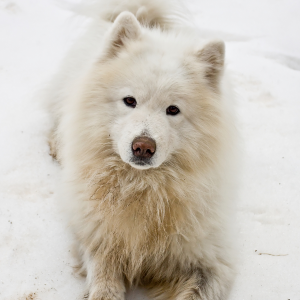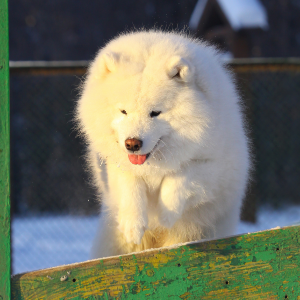
Samoyed
The Samoyed is a playful, alert breed that excels as both a family dog and a guard dog. Nicknamed "The Smiley Dog," these pups appear to have permanent smiles on their faces. Powerful, active members of the working dog group, Samoyeds—or "Sammies"—are happiest when playing outdoors with their people.
Interested in discovering if your dog is a Samoyed?
Check out Wisdom Panel's DNA tests.

Samoyed Traits
General Appearance
Samoyeds are medium-sized dogs with thick, weather-resistant coats. They are known for their fluffy, solid-white fur, bright eyes, and slightly upturned mouths.
Coat and Colouring
The Samoyed's coat comes in various shades of white—including biscuit, cream, and pure white. These are double-coated dogs with a short, soft, thick undercoat and longer coarse hair on the outer coat. Both males and females have a "ruff" around their necks and shoulders (but it may be more pronounced on males).
Distinctive Physical Traits
The "Samoyed smile" is the most distinctive (and adorable) trait of the breed. The upturned corners of their mouths, which give Sammies the appearance of a smile, help keep the dogs from drooling so icicles can't form around their mouths.
Samoyed Temperament
Samoyeds are good-natured, active dogs that develop strong bonds with their families. They love and expect attention, making them excellent companions for anyone who wants a dog to tag along on all of their activities. Sammies are friendly with children, strangers, and even other animals.
If Samoyeds are alone for long periods, they may get bored and destructive. Howling and digging are their preferred activities when left by themselves for too long. Despite their Arctic roots, Samoyeds are not dogs that want to live outside alone.


Samoyed History
The Samoyed's name comes from the nomadic Samoyedic people of Siberia—who bred these dogs to pull sleds, herd reindeer, and guard them against predators in frigid climates. Samoyeds also provided warmth, snuggling up with members of the tribe on the coldest nights. This popular breed still plays these dual roles of worker and loyal companion.
Queen Alexandra of Denmark received one of the first Samoyeds imported to England in 1889. And she became a lifelong fan of the breed. The Samoyed arrived in the United States in 1906, when the Russian Grand Duke Nicholas gifted a fluffy white dog named Moustan of Argentaeu to the nation. It was the first Samoyed registered in the American Kennel Club.
With few reindeer to herd in the U.S. and Europe, Sammies instead hauled supplies for explorers. They excelled at this job thanks to their strength, enthusiasm, and ability to work in harsh conditions. Samoyeds were part of the first team of explorers to reach the South Pole.
Today, the Samoyed is more likely to be hauling a wagonload of children to the park than hauling supplies across icy terrain. This good-natured breed has become a favorite family pet with an affectionate, up-for-anything attitude.
Samoyed Care
Nutrition
Samoyeds are prone to becoming overweight. Their thick coats can hide extra pounds, so it's important to feel their bodies and check with the vet to determine if they need to go on a diet.
This breed requires a high-quality dog food that's age-appropriate. Just be sure to portion out meals with a measuring cup to avoid overfeeding.
Sammies are food-motivated and respond well to treats as a training reward. But be careful not to offer too many. As a general rule, treats should make up no more than 10% of a dog's daily calories.
Grooming
Samoyeds shed. A lot. Daily grooming can remove excess hair as well as mats and tangles. During seasonal shedding periods—which can occur twice every year—an undercoat rake can help remove dead hair and keep Samoyeds looking their best. Regular nail trims and ear cleanings should also be part of grooming routines.
A good dental hygiene program is essential. Start a regular at-home dental care routine when your dog is young. And consult your veterinarian about professional dental cleanings so your Samoyed's smile always looks its best.
Exercise
Historically bred as working dogs, Samoyeds are active pets that require a lot of exercise. Daily walks—or runs—are a great start, but there are plenty of fun outlets for their energy. They love dog sports, such as sled or cart racing, packing, skijoring, agility, flyball, and obedience training.
Samoyeds also appreciate room to run. Their speed and endurance (combined with a strong urge to run) make a securely fenced yard or dog park essential for off-leash play. This Arctic breed prefers cold weather and may be happier with indoor activities during the hot summer months. Games and tricks offer Samoyeds much-needed mental stimulation, as well.
Training
Training a Samoyed requires a firm but loving touch. Since this breed bonds closely with its people, it's eager to please and loves the one-on-one attention that training provides. However, Samoyeds also have stubborn streaks that can make training a challenge. Incorporate social activities and positive, reward-based training with treats, toys, and praise to help them achieve training goals.
Sammies are intelligent, fast learners, so it's important to switch up training activities to keep them from getting bored. Group obedience classes where they can interact with other people and dogs while learning new tricks are ideal.

Samoyed Genetic Health Conditions
-
X-Linked Hereditary Nephropathy (Discovered in the Samoyed)
X-Linked Hereditary Nephropathy (XLHN) is a kidney disorder, leading to kidney failure.
-
X-Linked Progressive Retinal Atrophy 1
X-Linked Progressive Retinal Atrophy 1 (XLPRA1) causes degeneration of the light detecting retina at the back of the eye, resulting in loss of vision.
Knowing if your Samoyed is a carrier or at-risk for these conditions can help you and your veterinarian plan for your pup's lifelong care. With Wisdom Panel™ Premium, you can get results for over 200 genetic health tests.
Breed Group
Asian and Oceanian
The Asian and Oceanian group is comprised of breeds whose origins lie in Asia, which have spread as far as Australia, the islands of the Pacific, and the Arctic. This group is possibly the most ancient of all breed groups and were bred for a variety of purposes, including guarding, hunting, and as draft dogs.
Resources
https://www.akc.org/dog-breeds/samoyed/
https://vcahospitals.com/know-your-pet/dog-breeds/samoyed
http://images.akc.org/pdf/breeds/standards/Samoyed.pdf
Reviewed 26 July 2020 by Cindy Elston, DVM, MPH












































